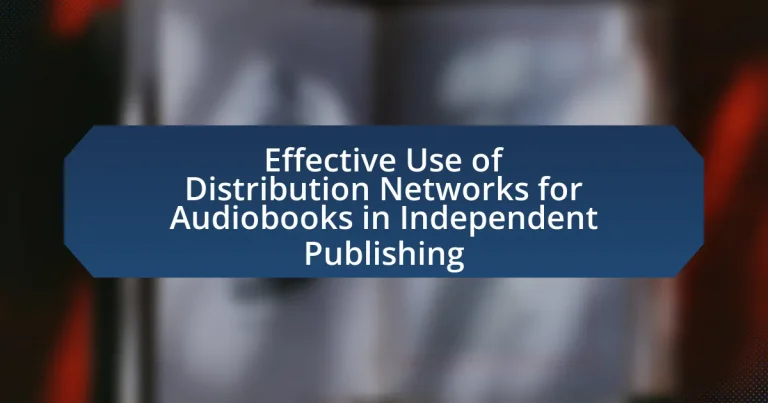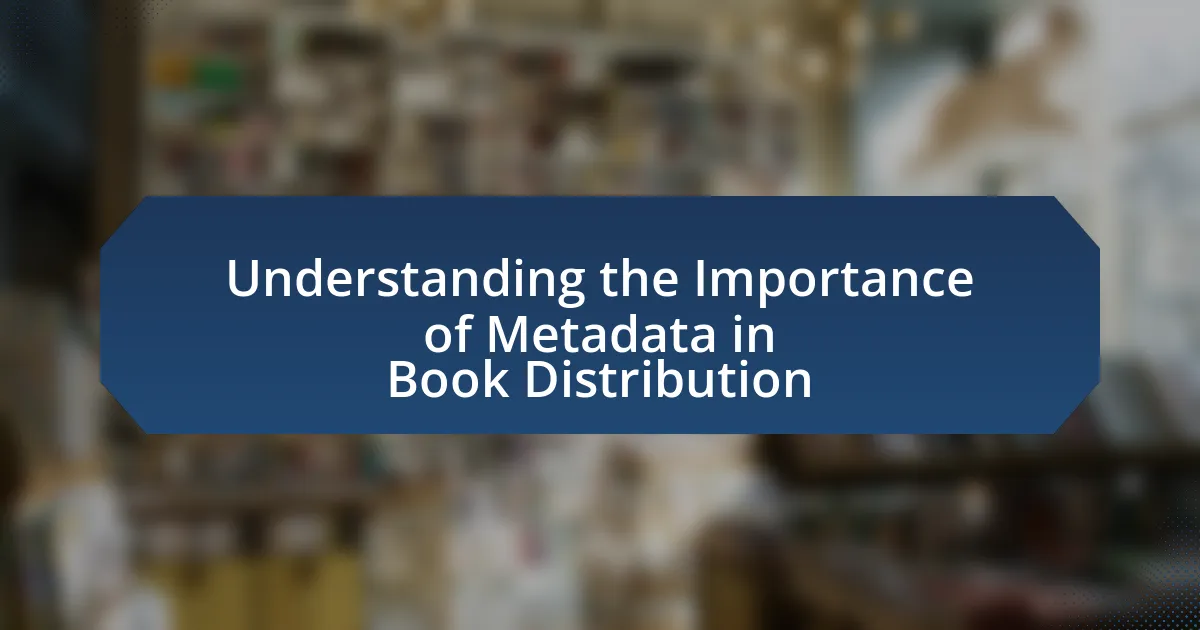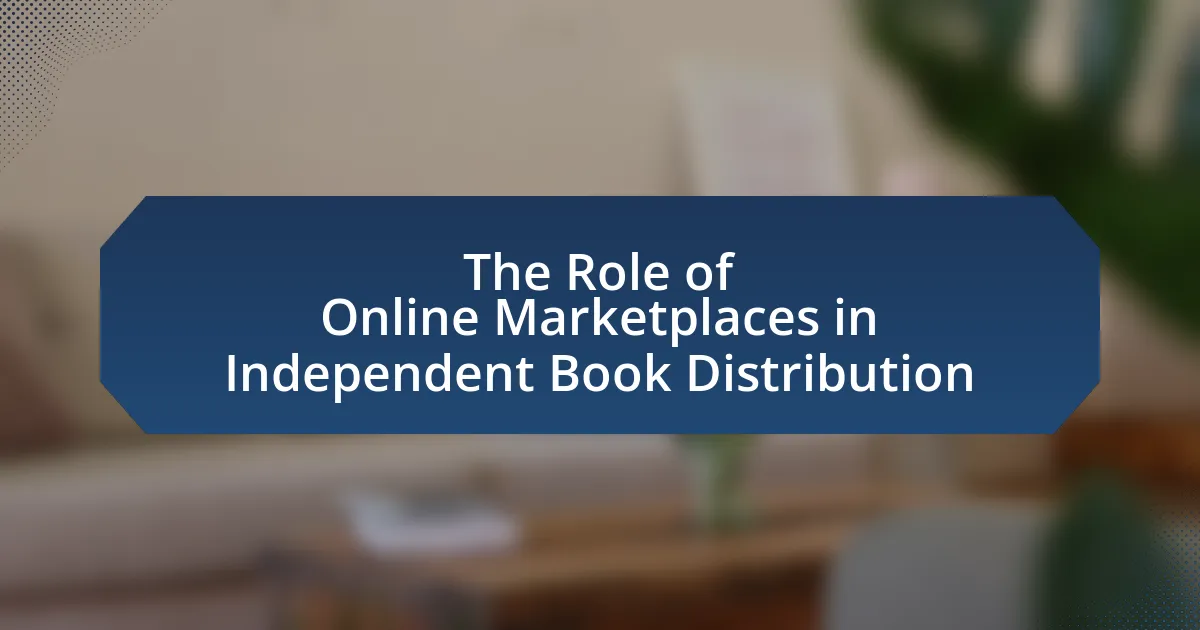Distribution networks for audiobooks in independent publishing are essential systems that connect independent authors and publishers to major retailers and platforms, such as Audible and Google Play. These networks, including aggregators like Findaway Voices and ACX, facilitate the distribution and sale of audiobooks, enabling independent creators to reach a wider audience and enhance their sales potential. The article explores the functioning of these networks, their key components, and the advantages they provide to independent publishers, while also addressing the challenges faced in accessing these distribution channels. Additionally, it outlines strategies for leveraging these networks effectively, measuring success, and optimizing audiobook listings to maximize visibility and engagement in a competitive market.
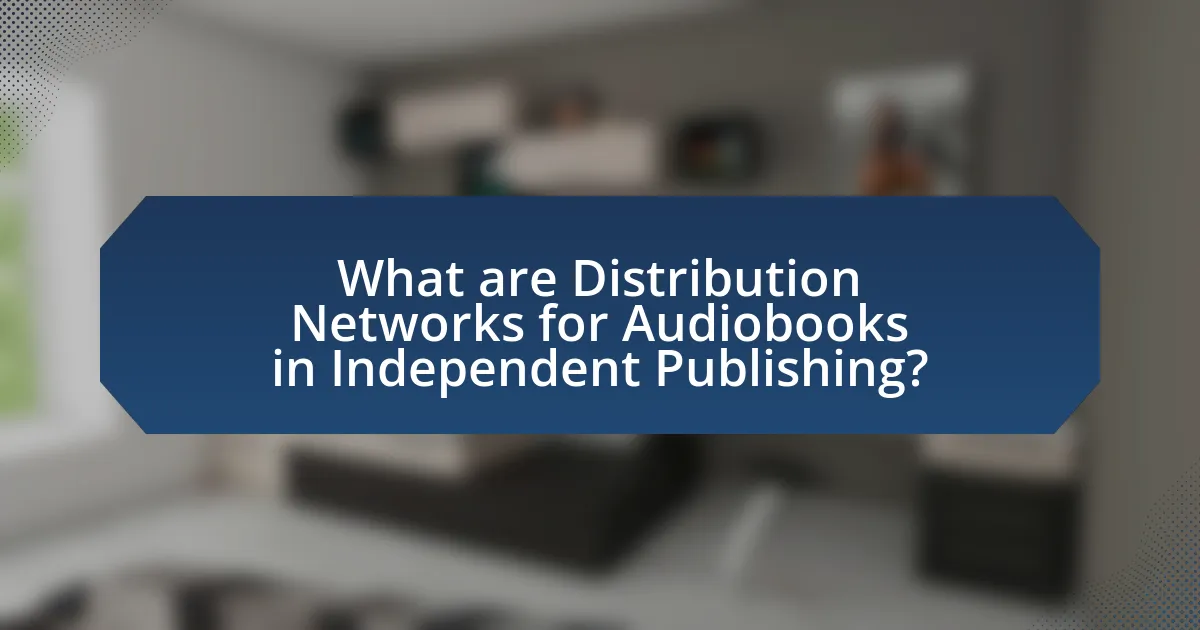
What are Distribution Networks for Audiobooks in Independent Publishing?
Distribution networks for audiobooks in independent publishing are systems that facilitate the distribution and sale of audiobooks to various platforms and retailers. These networks include aggregators like Findaway Voices and ACX, which connect independent authors and publishers to major audiobook retailers such as Audible, Apple Books, and Google Play. By utilizing these distribution networks, independent publishers can reach a wider audience, increase sales potential, and streamline the process of getting their audiobooks into the market. The effectiveness of these networks is evidenced by the growing trend of self-published audiobooks, which accounted for a significant portion of the audiobook market, reflecting the importance of accessible distribution channels for independent creators.
How do distribution networks function in the context of audiobooks?
Distribution networks for audiobooks function by connecting content creators, such as authors and narrators, with consumers through various platforms. These networks facilitate the distribution of audiobook files to retailers, libraries, and direct-to-consumer channels, ensuring that audiobooks reach a wide audience. For instance, platforms like Audible and Google Play Books serve as intermediaries, allowing independent publishers to upload their audiobooks and make them available for purchase or streaming. This system not only enhances accessibility for listeners but also provides authors with royalties based on sales, thereby creating a sustainable model for independent publishing.
What are the key components of audiobook distribution networks?
The key components of audiobook distribution networks include platforms, aggregators, and retailers. Platforms such as Audible and Google Play provide the infrastructure for hosting and delivering audiobooks. Aggregators like Findaway Voices and Draft2Digital facilitate the distribution of audiobooks to multiple retailers, streamlining the process for independent publishers. Retailers, including Apple Books and Kobo, serve as the end points where consumers purchase and access audiobooks. These components work together to ensure that audiobooks reach a wide audience efficiently, leveraging technology to optimize distribution and sales.
How do these components interact to facilitate audiobook distribution?
Audiobook distribution components, including production, platforms, and marketing, interact to streamline the delivery of audiobooks to consumers. The production process involves recording, editing, and mastering the audio content, which is then uploaded to distribution platforms like Audible, Google Play, and Apple Books. These platforms serve as intermediaries, providing access to a wide audience and facilitating sales transactions. Marketing efforts, such as social media promotion and email campaigns, drive traffic to these platforms, enhancing visibility and sales potential. This interconnected system ensures that audiobooks reach listeners efficiently, maximizing both exposure and revenue for independent publishers.
Why are distribution networks important for independent publishers?
Distribution networks are crucial for independent publishers because they facilitate access to a broader audience and enhance sales opportunities. By utilizing established distribution channels, independent publishers can reach retailers, libraries, and consumers more effectively than through direct sales alone. For instance, according to a report by the Independent Book Publishers Association, publishers who leverage distribution networks see an average sales increase of 30% compared to those who do not. This access not only increases visibility but also allows independent publishers to compete with larger publishers, ensuring their audiobooks are available on multiple platforms and formats, which is essential in a diverse market.
What advantages do distribution networks provide to independent audiobook publishers?
Distribution networks provide independent audiobook publishers with increased market reach and access to diverse sales channels. By utilizing established platforms, these publishers can distribute their audiobooks to a wider audience, including major retailers and libraries, which would be challenging to achieve independently. For instance, platforms like Audible and Google Play have millions of users, allowing independent publishers to tap into a vast customer base. Additionally, distribution networks often offer marketing support and promotional opportunities, enhancing visibility and sales potential for independent titles. This combination of broader access and promotional resources significantly boosts the chances of success for independent audiobook publishers.
How do distribution networks impact the reach of independent audiobooks?
Distribution networks significantly enhance the reach of independent audiobooks by providing access to a broader audience through various platforms. These networks facilitate the distribution of audiobooks to multiple retailers and libraries, increasing visibility and availability. For instance, platforms like Audible, Google Play, and Apple Books allow independent authors to reach millions of potential listeners, which would be challenging to achieve through direct sales alone. Additionally, statistics show that audiobooks are one of the fastest-growing segments in publishing, with revenue reaching over $1.3 billion in 2020, indicating a strong market demand that independent authors can tap into through effective distribution.
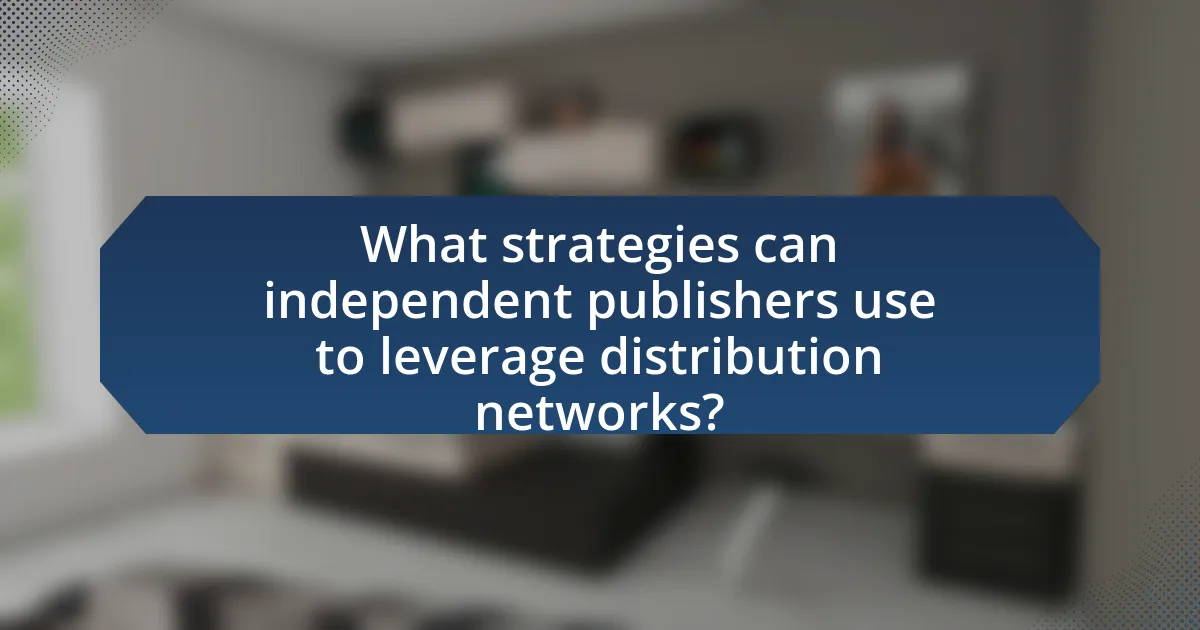
What strategies can independent publishers use to leverage distribution networks?
Independent publishers can leverage distribution networks by forming partnerships with established distributors and utilizing digital platforms. By collaborating with distributors like Ingram or Baker & Taylor, independent publishers gain access to extensive retail networks, increasing their visibility and sales potential. Additionally, using digital platforms such as Audible and Google Play allows independent publishers to reach a global audience, as these platforms have millions of users actively seeking audiobooks. Research indicates that independent publishers who engage with multiple distribution channels can increase their market reach by up to 30%, demonstrating the effectiveness of these strategies in enhancing distribution capabilities.
How can independent publishers select the right distribution network?
Independent publishers can select the right distribution network by evaluating their target audience, assessing the network’s reach, and analyzing the terms of distribution agreements. Understanding the demographics and preferences of their audience allows publishers to choose networks that effectively connect with potential listeners. For instance, platforms like Audible and Google Play offer extensive reach but may have different royalty structures, which publishers should compare to ensure profitability. Additionally, examining user reviews and success stories from other independent publishers can provide insights into the effectiveness of various networks. This approach ensures that the chosen distribution network aligns with the publisher’s goals and maximizes audiobook visibility and sales.
What factors should be considered when choosing a distribution partner?
When choosing a distribution partner for audiobooks in independent publishing, key factors include the partner’s reach, technology, pricing structure, and reputation. A distribution partner with extensive reach can ensure that audiobooks are available on multiple platforms, maximizing audience access. The technology used by the partner should support high-quality audio formats and efficient distribution processes. Additionally, a transparent and competitive pricing structure is crucial to maintain profitability for independent publishers. Finally, the partner’s reputation in the industry, including reviews and case studies, can provide insights into their reliability and effectiveness in promoting and distributing audiobooks.
How do different distribution networks compare in terms of services offered?
Different distribution networks for audiobooks offer varying services that cater to independent publishers’ needs. For instance, platforms like Audible provide extensive reach and marketing support, while services like Findaway Voices offer customizable distribution options and a wider selection of retail partners. Additionally, platforms such as ACX focus on connecting authors with narrators, facilitating the production process. These differences highlight how each network’s unique services can impact an independent publisher’s ability to reach audiences effectively and manage their audiobook production and distribution.
What marketing strategies can enhance the effectiveness of distribution networks?
Implementing targeted digital marketing strategies can significantly enhance the effectiveness of distribution networks for audiobooks in independent publishing. Utilizing social media advertising allows publishers to reach specific demographics, increasing visibility and engagement with potential listeners. Additionally, leveraging email marketing campaigns can foster direct communication with audiences, promoting new releases and exclusive content. According to a study by the Content Marketing Institute, 70% of consumers prefer to learn about products through content rather than traditional advertising, highlighting the importance of content-driven marketing strategies. Furthermore, partnerships with influencers in the audiobook space can amplify reach and credibility, as 49% of consumers rely on influencer recommendations for purchasing decisions. These strategies collectively optimize distribution networks by driving traffic and increasing sales conversions.
How can social media be utilized to promote audiobooks through distribution networks?
Social media can be utilized to promote audiobooks through distribution networks by leveraging targeted advertising, engaging content, and influencer partnerships. Targeted advertising on platforms like Facebook and Instagram allows publishers to reach specific demographics interested in audiobooks, increasing visibility and sales. Engaging content, such as audio snippets, author interviews, and behind-the-scenes looks, can be shared to attract potential listeners and drive traffic to distribution platforms. Additionally, partnerships with influencers who have a strong following in the audiobook community can amplify reach, as they can share recommendations and reviews, effectively driving their audience to purchase or listen to the promoted audiobooks. These strategies have been shown to enhance audience engagement and boost sales in the audiobook market.
What role does audience engagement play in maximizing distribution network effectiveness?
Audience engagement is crucial for maximizing distribution network effectiveness as it directly influences the reach and impact of audiobook content. Engaged audiences are more likely to share recommendations, leading to increased word-of-mouth promotion and broader distribution. According to a study by Nielsen, 92% of consumers trust recommendations from friends and family over any other form of advertising, highlighting the importance of audience-driven promotion in expanding distribution networks. Furthermore, active engagement fosters loyalty, encouraging repeat purchases and sustained interest in new releases, which enhances the overall effectiveness of the distribution strategy in independent publishing.
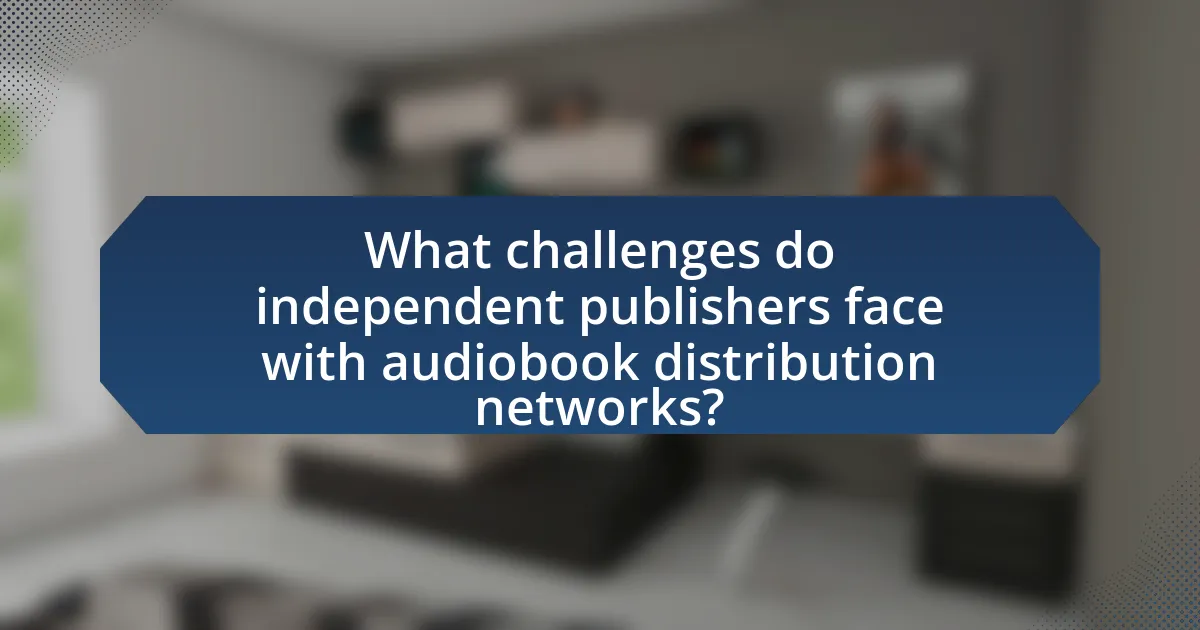
What challenges do independent publishers face with audiobook distribution networks?
Independent publishers face significant challenges with audiobook distribution networks, primarily due to limited access to major platforms and high competition. Many independent publishers struggle to secure partnerships with prominent distributors like Audible or Apple Books, which often favor established publishers with larger catalogs. Additionally, the costs associated with producing and distributing audiobooks can be prohibitive, as independent publishers may lack the financial resources to invest in quality production and marketing. According to a 2021 report by the Audio Publishers Association, independent publishers accounted for only 10% of the audiobook market, highlighting the competitive disadvantage they face. Furthermore, navigating the technical requirements and varying distribution agreements can complicate the process, making it difficult for independent publishers to effectively reach their target audience.
What common obstacles do independent publishers encounter?
Independent publishers commonly encounter obstacles such as limited financial resources, lack of marketing expertise, and difficulties in distribution. Limited financial resources restrict their ability to invest in quality production and marketing efforts, which are crucial for reaching a wider audience. Additionally, many independent publishers lack the marketing expertise necessary to effectively promote their audiobooks, leading to lower visibility in a competitive market. Furthermore, difficulties in establishing reliable distribution channels can hinder their ability to get their audiobooks into the hands of consumers, impacting overall sales and growth.
How can independent publishers overcome issues related to distribution costs?
Independent publishers can overcome issues related to distribution costs by leveraging digital distribution platforms that offer lower fees and wider reach. Utilizing services like Amazon Kindle Direct Publishing or platforms such as Draft2Digital allows independent publishers to distribute their audiobooks globally without the high overhead associated with traditional distribution methods. According to a report by the Audio Publishers Association, digital audiobooks accounted for over 50% of the audiobook market in 2022, highlighting the effectiveness of digital channels in reducing costs while maximizing audience access.
What strategies can be employed to address competition within distribution networks?
To address competition within distribution networks for audiobooks in independent publishing, strategies such as diversifying distribution channels, leveraging technology for data analytics, and enhancing customer engagement can be employed. Diversifying distribution channels allows independent publishers to reach a broader audience by utilizing multiple platforms, such as direct sales, third-party retailers, and subscription services. Leveraging technology for data analytics enables publishers to understand market trends and consumer preferences, allowing for more targeted marketing efforts. Enhancing customer engagement through personalized communication and community-building initiatives fosters loyalty and encourages repeat purchases. These strategies are supported by industry trends indicating that independent publishers who adopt a multi-channel approach and utilize data-driven insights tend to outperform competitors who rely on traditional single-channel distribution methods.
How can independent publishers measure the success of their distribution efforts?
Independent publishers can measure the success of their distribution efforts by analyzing key performance indicators (KPIs) such as sales volume, audience reach, and engagement metrics. Sales volume provides a direct measure of revenue generated from distributed audiobooks, while audience reach can be assessed through metrics like downloads and unique listeners across various platforms. Engagement metrics, including listener retention rates and reviews, offer insights into how well the content resonates with the audience. According to a 2022 report by the Audio Publishers Association, the audiobook market grew by 25% in revenue, indicating that effective distribution strategies can significantly impact sales and audience engagement.
What metrics should be tracked to evaluate distribution network performance?
Key metrics to track for evaluating distribution network performance include order fulfillment rate, delivery time, inventory turnover, and transportation costs. The order fulfillment rate measures the percentage of customer orders that are completed accurately and on time, which is crucial for customer satisfaction. Delivery time assesses the speed at which products reach customers, impacting overall service quality. Inventory turnover indicates how efficiently inventory is managed, reflecting the balance between supply and demand. Transportation costs evaluate the expenses associated with moving goods, which directly affect profitability. Tracking these metrics provides insights into operational efficiency and areas for improvement within the distribution network.
How can feedback from listeners inform distribution strategies?
Feedback from listeners can significantly inform distribution strategies by providing insights into listener preferences and behaviors. For instance, if listeners express a preference for specific platforms or formats, publishers can prioritize those channels for distribution. Additionally, feedback can reveal which marketing tactics resonate most with the audience, allowing for more targeted promotional efforts. Research indicates that 70% of consumers are more likely to recommend a brand after receiving a positive experience, highlighting the importance of listener satisfaction in shaping distribution choices. By analyzing listener feedback, independent publishers can optimize their distribution networks to enhance reach and engagement.
What best practices should independent publishers follow for effective audiobook distribution?
Independent publishers should utilize multiple distribution platforms to maximize audiobook reach and sales. By distributing audiobooks through various channels such as Audible, Google Play, and Apple Books, publishers can tap into diverse audiences and increase visibility. Research indicates that audiobooks are a rapidly growing segment of the publishing industry, with sales reaching $1.3 billion in 2020, highlighting the importance of broad distribution. Additionally, independent publishers should ensure high-quality audio production, as studies show that professional narration and sound quality significantly enhance listener engagement and retention. Implementing effective marketing strategies, such as social media promotion and collaborations with influencers, can further boost audiobook sales and audience engagement.
How can independent publishers optimize their audiobook listings for better visibility?
Independent publishers can optimize their audiobook listings for better visibility by utilizing targeted keywords, crafting compelling descriptions, and leveraging promotional tools offered by distribution platforms. Targeted keywords enhance searchability, as studies show that 70% of consumers use specific terms when searching for audiobooks. Compelling descriptions engage potential listeners, increasing the likelihood of purchases; research indicates that well-written descriptions can boost conversion rates by up to 30%. Additionally, using promotional tools such as discounts or featured listings on platforms like Audible or Findaway Voices can significantly increase exposure, as these platforms often highlight promotional content to their user base.
What are the key elements of a successful audiobook distribution plan?
A successful audiobook distribution plan includes selecting the right distribution channels, understanding target audience demographics, optimizing pricing strategies, and implementing effective marketing techniques. Selecting the right distribution channels, such as Audible, iTunes, and Google Play, ensures broad reach and accessibility. Understanding target audience demographics allows for tailored marketing efforts, increasing engagement and sales. Optimizing pricing strategies, including promotional discounts and bundling with other formats, can enhance attractiveness to potential listeners. Implementing effective marketing techniques, such as social media campaigns and partnerships with influencers, can significantly boost visibility and sales. These elements are supported by industry data showing that targeted marketing and diverse distribution channels lead to higher audiobook sales and listener retention.
